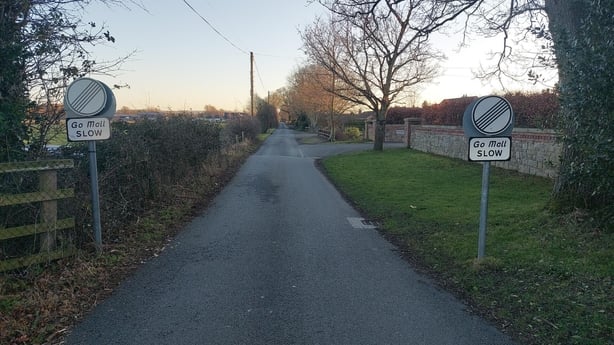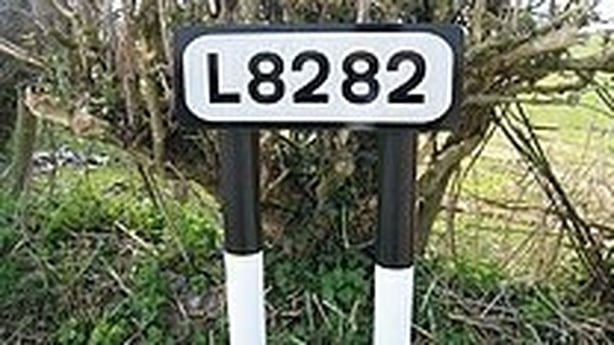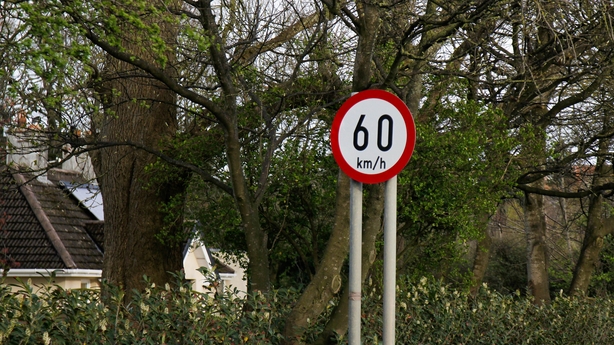"My husband, Steve was standing outside of his hackney [letting out two passengers] when he was knocked down and killed by a young unaccompanied learner driver on the Moville to Carndonagh [rural] road in Inishowen.
"Steve was lifted out of his shoes and flung into a field with the impact of the collision.
"His legs and arms were smashed. His spinal cord severed, and his internal organs torn from their natural position. He suffered massive head injuries.
"I had visions of him crying out for help. The doctor told me it's likely he died instantly.
"People are complaining about a reduction in speed limits: if they could only read some of the autopsy reports of precious lives lost in road traffic collisions."
Susan Gray lost her 51-year-old husband Steve in a road traffic collision in Oort, Co Donegal on 27 December 2004.
Following her husband’s death, Ms Gray founded 'PARC', a civil society group that advocates for road safety and helps those affected by serious road traffic collisions.
Ms Gray has welcomed the Government's decision to decrease the default speed limits on rural, local roads from 80km/h to 60km/h.
"Speed is a killer ... research has shown that nine out of ten pedestrians struck at 80km/h will not survive, while five out of ten pedestrians struck at 60km/h per hour will survive," she said.
"This reduction will make our roads safer, not only will it save lives, but it also reduces the number of people who suffer serious injuries."
The change in speed limit from 80km/h to 60km/h will impact rural, local roads (designated as L roads - eg L8282), which are often the first and last leg of many journeys in the countryside.
These roads primarily serve local traffic and are the arteries of many rural communities.
2,500 new speed signs in Co Donegal
The public road network in Donegal, as in other counties, consists of National Primary Roads, National Secondary Roads, Regional Roads and Local Roads.
The changes in the speed limit only impact on rural local roads.
Traffic volumes on these roads are generally significantly less compared to regional and national routes.
The public would consider National Roads and Regional Roads as the main roads linking our towns and villages - speed limits on these roads are not impacted.

Director of Roads and Transportation at Donegal County Council Bryan Cannon said: "The council has erected approximately 2,500 new signs which will inform the public of what speed limit applies to what road."
"These signs include numeric speed limit signs showing the speed limit and the Rural Speed Limit sign which is five diagonal black lines on a white circular sign.
"This Rural Speed Limit is used as an alternative to numeric speed limit signs on some single lane rural roads, will also now mean that a maximum 60km/h limit is in force."
Are there exemptions?
Local authorities can make bye-laws to retain the 80km/h speed limit on a rural local road if its characteristics such as width, alignment etc meet criteria set out in guidelines.
Donegal County Council has adopted bye-laws that will see four sections of local road retaining the 80km/h speed limit.
A section of the Ardaghy to Ardara Road;
A section of the Ballintra to Laghy Road;
A section of the Racecourse Road from Muff to the Border with Northern Ireland;
A section of the Whinhill Road Bridgend to the Burnfoot to Muff Road.
Speed limit signs will be erected to clearly identify the sections of these roads that will remain at the 80km/h speed limit. The council held a public consultation last year in relation to these changes.
What does the data show?
Road Safety Authority data shows that 107 people died in road traffic collisions on local rural roads between 2020 and 2024, accounting for 14% of all road fatalities in this time.
Around 882 people sustained serious injuries because of road traffic collisions on local roads between 2020 and 2024, accounting for 12% of all serious injuries recorded by the RSA during the same time.
RSA figures from 2021 onwards are provisional and subject to change.
What about our international counterparts?
International research indicates that speed is a contributory factor in a third of fatal collisions, and that reducing speed significantly reduces road deaths.
France lowered the speed limit from 90km/h to 80km/h on rural two-way roads without central delineators in 2018.
Academic research in the Journal of Safety Research found the reduced speed limit resulted in an overall reduction of 10% in the number of fatalities during the first two years of the new measure.
Since 2020, regional French authorities have been able to revert to a 90km/h speed limit if several pre-conditions are enacted to ensure road safety.
The modification from the French government followed nationwide protests by the yellow vest movement as well as widespread vandalism of speed cameras.
In the Belgian region of Flanders, speed limits for rural roads were reduced from 90km/h to 70km/h in January 2015.

A presentation published by the Flander’s Department of Mobility and Public Works last year estimated the measure resulted in a 23% reduction in deaths and serious injuries.
In September 2023, the Welsh government introduced a measure reducing the default 50km/h speed limit to 32km/h on mostly urban roads.
A petition calling for the measure to be overturned in Wales reached almost half a million signatures in a nation home to three million people. Anger at the decision remains.
The Welsh government said in a statement last week there were about 100 fewer people killed or seriously injured on 50km/h and 32km/h roads in the 12 months after the introduction of the new speed limit.
Welsh cabinet Secretary for Transport Ken States said "the picture continues to be encouraging" while adding "it will take a number of years to see the full impact of the policy".
The Welsh government's Chief Statistician Stephanie Howarth has said at least three years’ worth of collision data would be required post-implementation to compare with at least a three-year pre-implementation period for a meaningful comparison.
The policy is under review in Wales.
Many local authorities are reviewing whether they should revert to the previous speed limit.
What’s the big picture in Ireland?
The Government’s current road safety strategy focuses on achieving 'Vision Zero' - zero road deaths or serious injuries by 2050.
The Government Road Safety Strategy 2021-2030 has the primary aim of reducing the number of deaths and serious injuries on Irish roads by 50% by 2030 in alignment with targets adopted by member states across the EU.
The phase one action plan for the strategy set out the need for a working group of relevant stakeholders to review speed limits, to help set consistent and appropriate speed limits across the road network.
The Speed Limit Review was published in September 2023.

It concluded that protecting vulnerable road users must be a key focus when setting speed limits.
Based on modelling and research on international practice, the review recommended the lowering of default speed limits on urban, local and national secondary roads.
This change from 80km to 60km on rural local roads is the first step.
Recommendations from the review have been incorporated into the Road Traffic Act 2024, which provides the legislative basis for the changes to default speed limits.
Speed limits in our town and village centres will be reduced to 30km/h in the future.
It is envisaged the default speed limit on National Secondary Roads will be reduced from 100km/h to 80km/h.
There is no proposal to reduce the default speed limit on ‘Regional Roads’ (roads designated with an R followed by a number), which will remain at 80 km/h.
What’s the penalty for exceeding the speed limit?
Anyone caught driving over the speed limit will receive three penalty points and a fixed charge fine of €160.
If the fine is not paid within 28 days, it increases to €240, and if this increased fine is not paid, a court summons will be issued.
If convicted, you could be fined up to €1,000 and receive up to five penalty points.
Gardaí have warned motorists to slow down and be conscious of the new lower rural and urban limits.
What about ‘poor quality’ rural roads?
This is a bone of contention in rural areas, where people feel the road, they travel daily may have several potholes, swathes of grass growing in the middle or hedges and briars encroaching onto an already narrow bóithrín.
Speaking on RTÉ's Morning Ireland yesterday, Minister of State at the Department of Transport Sean Canney said there is "no point" in reducing speed limits on rural roads, if it does not coincide with investment in maintenance.
We need your consent to load this rte-player contentWe use rte-player to manage extra content that can set cookies on your device and collect data about your activity. Please review their details and accept them to load the content.Manage Preferences
Those comments will be welcomed by rural dwellers who depend on their vehicle as a primary means of transport.
Will this affect journey times in the countryside?
Not necessarily. As people who live on a single lane local road rural Ireland know - it's more the exception than the norm when a driver passes your home at a speed of more than 60km/h or 80 km/h.
What has the Minister for Transport said?
Minister for Transport Darragh O'Brien said "systemic changes like speed limit reduction and road safety education - along with enforcement - have helped us significantly bring down road deaths, but in recent years this trend has worryingly reversed.
Mr O'Brien added: "Together we can make our roads safer, by observing the speed limit, driving safely and looking out for one another on rural local roads."

The RSA launched a public awareness campaign yesterday to highlight the updated meaning of the 'Rural Speed Sign.'
This campaign will encompass audio and visual ads across video-on-demand, radio, and social media until the end of the month.
To further support the 'Slower Speeds, Safer Roads' initiative and the reduction of speed limits on rural local roads, the RSA will launch a new TV-led speeding campaign on 1 March.
Meanwhile, Ms Gray said a reduction in speed limits must be followed by huge enforcement.
"I have such respect for Garda Roads Policing Units and what they do, but they need more support and personnel," Ms Gray said.
Back to the roads of Donegal
The northwest has witnessed many difficult days due to road traffic collisions resulting in the death of loved ones or serious injuries over the years.
Last October, we filmed at a two-day road safety show, organised by Donegal Road Safety Working Group in conjunction with Donegal County Council as part of ongoing effort to promote safer road behaviours.
"Trying to live a normal life isn't easy"
During that event, Rachel Elliot and Bernadette Rice told their stories.
When brave people such as Ms Elliot and Ms Rice share their stories it provides perspective and clarity on the fragility of life when we discuss road safety.
Ms Elliot described how she lost two friends in a road traffic collision after a night out in Bundoran on 19 August 2018.
The driver reached a speed of 121km/h some 503 metres before he crashed. Six people were in the car. Two passengers died. Ms Elliot was left with life-changing injuries.
"I will never come to terms with the fact that I cannot walk but I have to live with it, living in a wheelchair.
"Trying to be a mum. Trying to live a normal life isn’t easy," Ms Elliot added.
Ms Rice lost her twin sister, Clarice, in a road traffic incident on 27 December 2019 and she poignantly described the impact of her sister’s passing.
"Clarice was 26 years old. She had a three-year-old daughter when she passed away. It was Christmas time. She was driving too fast and unfortunately it resulted in her tragic death.
We need your consent to load this rte-player contentWe use rte-player to manage extra content that can set cookies on your device and collect data about your activity. Please review their details and accept them to load the content.Manage Preferences
"Tragically, I have a niece now who we adore and love. She has to go now through life without her mammy through unfortunate events.
"Even if I saved one life today; it's a message I just want to get across. We have to slow down and respect the roads."
Before that road safety event started, teenagers from secondary schools across Donegal and the border region were full of the joys of spring, chattering, laughing and joking. Afterwards, the silence was palpable.
Speaking to us at that event last October, garda superintendent David Kelly detailed the three-pillar approach to road safety comprised of engineering, enforcement, and education.
Supt Kelly said: "They’re hearing a person who dies in a road traffic collision is not a statistic. They’re a person. There's devastation left behind for their families and friends."
Will the new speed limits make a difference?
While changing speed limits is not a panacea for all our problems regarding road safety; it is a vital piece of the jigsaw.
The RSA has said the decision to reduce speed limits is based on clear scientific evidence showing that speed directly affects the likelihood and severity of collisions.
A slower impact speed significantly reduces injury severity, as the force of a collision increases with speed.
Mr Cannon said: "Respecting the new speed limits will contribute to improved road safety".
"We all have a personal responsibility for safety on our roads and every one of us can take actions to improve road safety," he added.
Last year 174 people lost their lives on the country's roads. So far this year, there have been 16 road deaths.
Local roads - arteries of many rural areas
Local rural roads are the thoroughfares across many townlands in the countryside.
The communal bond, respect and empathy within our communities is central to the rural Irish identity.
When a death or serious injury occurs in a rural area because of a road traffic incident - the devastation often ripples far beyond the affected family and immediate friends.
I’ve found in my time reporting across the western and north western seaboard that people will generally accept measures focused on ensuring safety of their family and neighbours, in the interest of the greater good, even if they slightly disagree with the measure itself.
Unless Ireland becomes an outlier in comparison to other European states who have already adopted similar initiatives - it’s likely that the change will have a positive impact in respect of road safety.
If lives in our communities are saved the new measures can only be described as positive.







